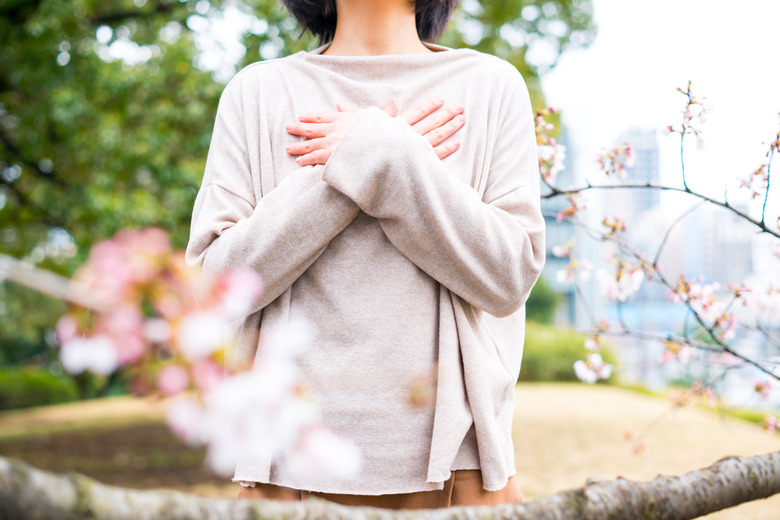Organ Systems Involved In Homeostasis
Homeostasis is the process by which the body regulates its internal environment for chemical and biological processes to occur. Some of the more important variables that the body needs to control include temperature, and the levels of blood sugar, oxygen and carbon dioxide. A number of organs are involved in homeostasis, and these include the lungs, pancreas, kidneys and skin.
TL;DR (Too Long; Didn't Read)
Homeostasis is the process that the body uses to maintain stability. The lungs are involved in respiration, exchanging carbon dioxide in the bloodstream for oxygen from the air. The pancreas regulates blood-glucose levels with the release of insulin or glucagon. The hypothalamus detects how much water is present in the blood, and controls how much water the kidneys hold or excrete in urine. The skin controls body temperature in two ways. It releases sweat to cool the body when its temperature is too high, and it flattens or stands up body hairs to release heat or insulate the body, depending on what the body needs.
Lungs and Respiration
Lungs and Respiration
Respiration is a process that uses glucose to create energy. It is the most important reaction taking place within the human body. Critical to the respiration process is the regulation of oxygen levels within the blood, which is carried out by the lungs. In addition to energy, respiration creates carbon dioxide from the broken down glucose. The level of carbon dioxide in the bloodstream is an indirect measure of blood oxygen levels. Special cells in the brain detect the carbon dioxide level in the blood, and if it is too high, the brain sends nerve impulses to stimulate the muscles that control breathing. The lungs then fill with air faster, increasing the amount of oxygen in the bloodstream. If carbon dioxide levels within the blood are low, the brain cells do not stimulate nerve cells, reducing the rate of breathing.
Pancreas and Blood Glucose
Pancreas and Blood Glucose
The regulation of blood-glucose levels is essential for the survival of the human body. The pancreas, a small glandular organ located close to the stomach, has a number of functions. One of the most important is the regulation of blood-glucose levels. The pancreas contains special cells known as the Islets of Langerhans that detect blood-glucose levels. If the blood-glucose levels are too high, the cells release the hormone insulin to stimulate liver, muscle and fat cells to absorb glucose from the blood and store it as glycogen or starch. When blood sugar levels are too low, the cells release another hormone called glucagon. Glucagon acts on the liver, muscle and fat cells and stimulates them to convert glycogen to glucose, releasing it into the blood.
Kidneys and Water Regulation
Kidneys and Water Regulation
Water acts as an essential solvent that allows glucose, salt and other chemicals to travel throughout the body. Kidneys regulate the amount of water present in the human body. When the level of water in the bloodstream becomes too low, the hypothalamus in the brain releases a large quantity of the chemical anti-diuretic hormone, ADH. ADH travels through the blood and stimulates the kidneys to open water channels within its tubule walls, allowing water to diffuse back into nearby blood vessels and reducing the amount of water in urine. When too much water is present in the blood, the hypothalamus releases smaller amounts of ADH. This causes the kidneys to close water channels within the tubule walls, increasing the amount of water in urine.
Skin and Sweat
Skin and Sweat
The body's temperature is tuned to approximately 98.6 Fahrenheit, which allows the body's biological enzymes to function at optimum level. When the body temperature rises, the hypothalamus sends nerve signals to sweat-producing cells in the skin. The body can sweat one to two liters of water per hour, which helps to cool the body. The skin also has tiny muscles on its surface called arrector pili. These muscles control the orientation of hairs on the skin. When the body is too hot, the muscles relax and the hairs lay flat to release heat. When the body is too cold, the arrector pili muscles contract, leading the hairs of the skin to stand up and insulate the body.
Cite This Article
MLA
Markings, Samuel. "Organ Systems Involved In Homeostasis" sciencing.com, https://www.sciencing.com/organ-systems-involved-homeostasis-4920/. 16 April 2018.
APA
Markings, Samuel. (2018, April 16). Organ Systems Involved In Homeostasis. sciencing.com. Retrieved from https://www.sciencing.com/organ-systems-involved-homeostasis-4920/
Chicago
Markings, Samuel. Organ Systems Involved In Homeostasis last modified August 30, 2022. https://www.sciencing.com/organ-systems-involved-homeostasis-4920/
